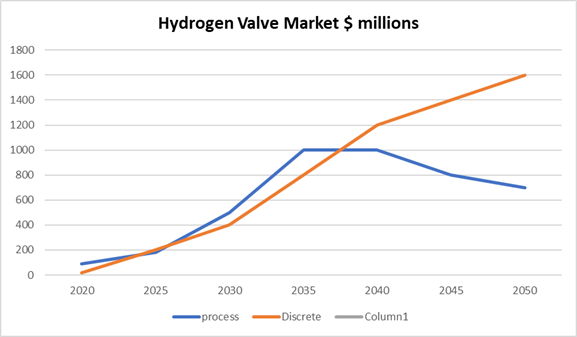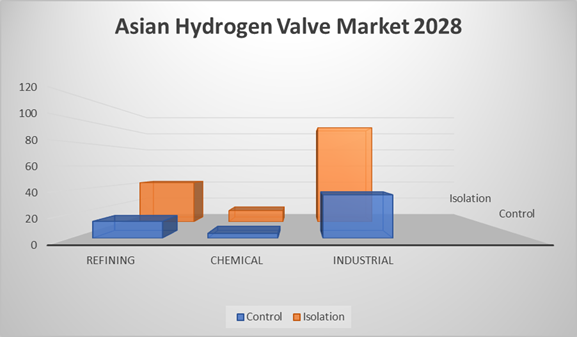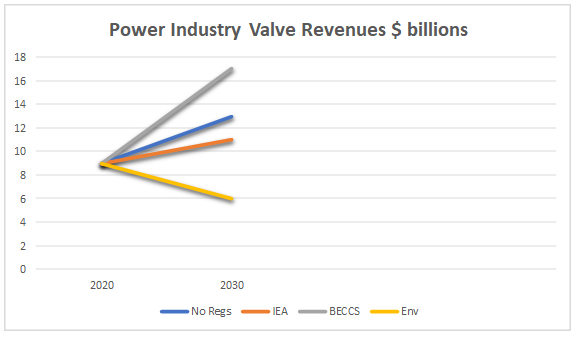REQUEST FOR HYDROGEN VALVE VALUE PROPOSITION
30% EBITDA and 20% market share is achievable in
narrow niches.
This entails validation of each niche
value proposition. In this regard Mcilvaine is
writing feature articles in many magazines. In
Valve World Americas an article this month
covers the HYDROGEN VALVE market and the
potential in various niches. In September a
number of value propositions submitted by valve
companies will be published. We are inviting you
to submit a proposition with no more than four
sentences. The relevant application codes and
valve types should be included as per the
examples.
Please submit your value proposition by August
1.
Bob Mcilvaine is available to answer questions
on this at 847 226 2391.
rmcilvaine@mcilvainecompany.com
Here are the details and the market article.
Examples of Hydrogen valve niche value
propositions
|
Company |
Application |
Valve type |
Value Proposition |
|
KSB Sisto |
PELE, FG, FL |
Check |
Swing check valves have special coatings. |
|
ITT Habonim |
PSMR, PPO, FL, SM, SW, SC, SW, UGT, TP, TS, UCO, UW, URE, UCH, UST, USH |
ball |
Cryogenic ball valves are designed for performance in the most demanding applications. The Total HermetiX Integrity package provides emission prevention tested and certified stem sealing, Fire safe certified design, and superior body and inline sealing at deep cryogenic temperatures. |
|
Bray |
PELE, SW |
Butterfly |
The McCannalok double offset butterfly valve) features an innovative design that offers rugged reliability and extremely easy maintenance in the field |
|
Swagelok |
UTC |
needle |
A bottom-loaded stem design reduces any potential stem blowout, offering enhanced safety. |
|
Ampo |
PSMR, FCG, FL |
Ball valve |
Hypercentric ball valve with its proven sealing concept combines the strength and integrity of metal-to-metal trunnion ball valve with positive sealing performances of the triple offset butterfly valve. Its friction free design and metal-to-metal sealing extends valve’s life. |
|
Velan (Flowserve) |
PELE, PSMR, FL, SM, , SC,URE, UCH, USH |
Butterfly |
In the double offset, an exceptionally tight shut-off is achieved with eccentric disc rotation combined with a unique sealing system, VELFLEX. This patent technology overcomes even high temperature fluctuations. |
Hydrogen Applications
|
Abrev. |
Prouction Methods |
Abrev. |
Transportation |
|
PELE |
Eletrolyzers |
TP |
pipeline |
|
PSMR |
Steam methane reformation |
TR |
road |
|
PPO |
Partial oxidation |
TS |
ship |
|
PO |
other |
TT |
train |
|
|
Form |
S |
Storage |
|
FG |
gas |
|
Use |
|
FCG |
Compressed gas |
UGT |
Gas turbines |
|
FL |
Liquid |
UIC |
IC Engines |
|
FA |
ammonia |
UCO |
Coal fired boilers |
|
|
Sources |
UW |
Waste to Energy |
|
SM |
methane |
URE |
refineries |
|
SW |
water |
UCH |
Chemical Plants |
|
SC |
coal |
UST |
Steel |
|
SW |
Waste and biomass |
USH |
ships |
Additional application details can be included
in the proposition. There can be sub-niches or
niches just within a sub process.
For example, Isolation Valves for Severe
Service within SMR
encounter temperatures and pressures which can
reach or exceed 1,500°F and 1,500 psig,
respectively. These elevated temperatures and
pressures are prevalent throughout various
modules of and applications within the SMR
process, including:
• Reformer
• Boiler Feed Water
• Feed Gas Lines
• Steam Drum Bridles
• Purging Applications
• Blowdown Applications
Each is a sub-niche and can be combined in a
niche which will be most profitable.
So, this additional granularity should be
included in the value proposition as well as the
niche forecasts.
The valve type is part of the value proposition.
It is part of the market share calculation. So,
standardization is a goal. Any input relative to
improving the listings will be considered.
Isolation versus control is one division.
Mcilvaine also has four service
categories: severe, critical, unique and
general.
|
Valve type |
Sub 1 |
Sub 2 |
Sub 3 |
|
Ball |
Floating/Trunnion |
Rising stem |
Metal seated |
|
Butterfly |
Double Offset |
Triple Offset |
|
|
Check |
|
|
|
|
Diaphragm |
weir |
Full bore |
|
|
Gate |
Parallel/Wedge |
Rising stem |
Knife gate |
|
Globe |
|
|
|
|
Plug |
|
|
|
|
Pressure relief |
Safety relief |
|
|
|
Solenoid |
|
|
|
|
Needle |
|
|
|
Latest Developments in the Hydrogen Valve Market
A number of governments, operators and suppliers
are betting on hydrogen as a major tool to meet
greenhouse gas goals.
In terms of valves, there are two markets:
discrete and process.
The discrete market includes small valves
used with fuel cells in mostly mobile
applications.
Many automotive companies are moving
forward with hydrogen fueled vehicles.
Discrete is defined as a valve associated with a
piece of equipment.
Swagelok furnishes check valves for
vehicle fuel cells.
These are small valves and are sold to
vehicle or fuel cell manufacturers.
Process includes the production and transport of
hydrogen as well as use in processes such as
steam generation or compression or heat
generation using combustion with hydrogen as the
primary or secondary fuel. Process also includes
the creation of chemical products.
Since the discrete market involves small valves
and a unique set of customers, the suppliers are
not the same companies furnishing the larger
process valves.
The process market preceded the discrete market.
But presently much of the activity is in
the discrete segment.
Over the next 15 years the process
expansion will outstrip discrete.
However, by 2040 the discrete market will
be advancing while the process market slows
down.

A detailed analysis has been made for the
process valve market for hydrogen through 2028
(1)
Coverage includes:
|
Production Methods |
Transportation |
|
Eletrolyzers |
Pipeline |
|
Steam methane reformation |
Road |
|
Partial oxidation |
Ship |
|
Other |
Train |
|
Form |
Storage |
|
Gas |
Use |
|
Compressed gas |
Gas turbines |
|
Liquid |
IC Engines |
|
Ammonia |
Coal fired boilers |
|
Sources |
Waste to Energy |
|
Methane |
Refineries |
|
Water |
Chemical Plants |
|
Coal |
Steel |
|
Waste and biomass |
Ships |
Coverage included gray, green, blue and yellow
hydrogen. Much of the near-term valve potential
is in gray and blue hydrogen. The gray hydrogen
includes the valves for partial combustion and
also for purification processes such as pressure
swing adsorption.
For molecular sieve switching metal
seated ball valves compete with triple offset
butterfly valves.
The potential for yellow hydrogen is
substantial.
Environmentalists have recognized the
need for carbon negative processes.
Biomass combustion with carbon capture
and sequestration (BECCS) is the only
cost-effective carbon negative option.
The conversion from gray to blue hydrogen
entails carbon capture and sequestration. The
many valves in the absorption and separation as
well as liquefaction and transport are included.
23,000
forecasts by country, valve type, function and
application for the 2022-28 were created.

There was also an analysis by region.

Analysis of the valve companies and the products
which they are supplying for hydrogen
applications shows that acquisitions are
positioning some valve companies to improve
their market share.
ITT has purchased Habonim. Atlas Coco and
Ingersoll Rand have combined valves with
compressors and other complementary products to
pursue markets such as hydrogen.
The hydrogen process valve market is highly
dependent on the mix of fuels for the power
industry.
An electric car plugged into an electrical
outlet can be using fossil fuel.
The fuel cell eliminates this route. To
the extent hydrogen replaces coal or gas for
combustion there is not an increase in valve
revenues.
Valve expenditures per kWh can be compared.
If solar or wind is used to make hydrogen which
then is used in fuel cells, the valve purchases
could range from 20 to 70% of a coal fired plant
when you consider both production and use.
|
Relative valve costs /kWh |
|
|
Coal |
1 |
|
BECCS |
2.5 |
|
Green hydrogen |
0.2-0.7 |
|
Nuclear |
1.2 |
|
Hydro |
0.3 |
|
Wind |
0.02 |
|
Combined Cycle |
0.5 |
|
Geothermal |
0.7 |
|
Solar |
0.01 |
Hydrogen use is only one of the variables in
determining valve sales to the power industry.

Yellow hydrogen using biomass will have niche
uses. But BECCS is just as yellow (carbon
negative). This option requires the most valves.
So, the extent to which BECCS is adopted the
valve market will increase.
Present yearly valve sales to the power industry
around the world are $9 billion. (1)
There will be robust growth under the BECCS
based strategy outlined here. If countries do
not continue to strive for GHG emissions to meet
the Paris agreement (No Regs) there will be
modest growth in line with GDP. With a mix of
technologies such as envisioned by IEA to meet
net Zero there will be low growth. If the
environmentalists were to dictate a mix heavily
dependent on solar and wind (Env), there would
be significant revenue reduction over the next
10 years.
Electrolysis
Today, electrolyzers, the devices used in
production typically utilize one of two
technologies: low-pressure electrolysis or
high-temperature electrolysis. Technological
development has already seen us move up to
large-scale 20MW electrolyzers, but 100MW units
are not too far in the future. Several valve
manufacturers are confident that they have the
valves to fulfill the requirements of
electrolysis applications for the PEM, AWE or
SOEC electrolyzers of both today and tomorrow.
Capital costs of electrolyzers uninstalled range
from $1000 to $1500 /kw. Lifetime is estimated
at 75,000 hours.
For every kg of hydrogen produced, 9 kg of water
must be consumed. Therefore, 2.3 Gt of hydrogen
requires 20.5 Gt, or 20.5 billion m3, per year
of freshwater, which accounts for 1.5 ppm of
Earth’s available freshwater. Most applications
for hydrogen require it to be combusted or
pumped through a fuel cell, which converts
hydrogen gas into electricity and water, but
while most water can be recovered, it is not
generally returned to the original body of water
and will be treated as consumed. The only sector
in which the use of hydrogen does not regenerate
the entirety of the water feedstock by fuel cell
or combustion is chemical synthesis, which will
account for 540 Mt of hydrogen, using at most
4.8 billion m3 or 0.3 ppm of global freshwater
annually.
In the Norwegian industrial estate of Porsgrunn,
a major German engineering contractor in the
technical gases industry is currently building a
24 MW electrolysis plant for producing green
hydrogen as a feedstock for green ammonia, which
is required in fertilizer production. The
necessary hydrogen is to be generated by means
of electrolysis using hydropower.
in 2022, the KSB Group supplied pumps and valves
for this plan.
Luxembourg-based valve manufacturer Sisto
Armaturen S.A., which is part of the KSB Group,
supplied its Sisto-RSK swing check valves
equipped with a special coating.
Much of the process valve market will be
generated through fossil fuels using SMR and
other technologies.
At lower temperatures and pressures,
torque-seated gate valves, often equipped with
either solid Stellite® or Stellite®- welded
overlay trims, may suffice for applications that
do not require tight shutoff. Torque-seated
valve designs involve the application of
substantial forces to the valve components to
adequately seal against line pressure.
Over time, these forces wear down the critical
sealing components of the valve, resulting in
shortened product longevity versus those of
position-seated valve designs.
As temperatures and pressures rise, gate valves
are often replaced by Y-pattern globe valves,
similarly equipped with either solid Stellite®
or Stellite®- welded overlay trims, to achieve
improved shutoff performance at initial
installation. Unfortunately, the improved
shutoff performance of globe valve is offset by
the following disadvantages:
• Substantial pressure drop across the valve
• Short product longevity
To address the underperformance of globe valves
in severe-service applications, companies
engineer and manufacture quarter-turn,
metal-seated floating ball valves (‘MSBVs’) that
can achieve a ‘bubble-tight’ seal per ANSI FCI
70.2 Class VI shutoff – or better. The quarter
turn mechanics of a MSBV not only eliminates
packing leaks, but also enables the usage of low
emissions packing that complies with prevailing
fugitive emissions certifications, such as API
STD 641.
Forecasting the valve revenues in the short term
is challenging.
Forecasts to 2050 include so many
variables that constant adjustments will be
required.
(1)
Hydrogen Valves, published by the Mcilvaine
Company
